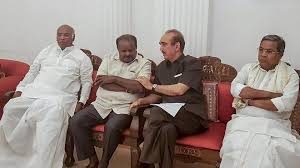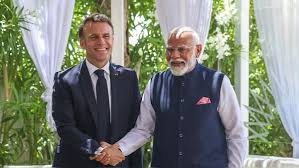
The election results of the recently-concluded Karnataka Assembly are not a Black Swan. Fractured political verdicts are not new to India. Neither are pre-or post-results alignments. Nor the fact that the party with the highest vote share will necessarily get the highest number of seats. Despite a high-decibel campaign on both sides, neither of the Big Two have been able to command a decisive majority — the Bhartiya Janata Party (BJP) has got 104 seats (46.4%), while the incumbent Indian National Congress (Congress) cobbled together 78 seats (34.8%). Of the rest, Janata Dal (Secular) or JD(S) has garnered 37 seats (16.5%), leaving three seats for independents.
We are now familiar with all these permutations and combinations in India’s increasingly ideology-free and power-embracing polity. They represent the adaptation of Indian politics to the changing direction brought about by a newer and younger electorate, the continuing rise of regional and state-focussed power centres, and reversal in the direction of issues, be they development or entitlements, to States from the Centre. Ever since the BJP came to power at the Centre, every State election has been hard fought. And so it is in Karnataka.
We are now familiar with all these permutations and combinations in India’s increasingly ideology-free and power-embracing polity. They represent the adaptation of Indian politics to the changing direction brought about by a newer and younger electorate, the continuing rise of regional and state-focussed power centres, and reversal in the direction of issues, be they development or entitlements, to States from the Centre.
Between allegations and their counters, Constitutional interpretations and party pushbacks, political pleas and their judicial hearings, Karnataka Governor and BJP veteran leader Vajubhai R. Vala has invited BJP’s State president B.S. Yeddyurappa to form the government, he has been sworn in and has changed his Twitter profile to reflect his new designation, the Chief Minister of Karnataka. The resultant cries from the Congress as well as the party approaching the Supreme Court at midnight were on predictable lines. For now, the court has ruled that government formation may move as planned, and it would hear the matter on 18 May. Yeddyurappa has two weeks to prove his majority in the Assembly.
Step back from the heat and dust of Karnataka electoral battle and what we see is an institutionalisation of a new political disruption. The fact that it is no longer enough to garner the maximum number of seats to be able to govern a State has brought a unique play to India’s politics. This disruption has now become an emerging trend. It began with Goa and Manipur in 2017 and Meghalaya in 2018, where despite Congress being the party with the largest number of seats, the BJP aggressively and proactively snatched political victories out of the jaws of electoral defeats, leaving the Congress crushed under its own weight of familial entitlements. In all these small States, political inertia and taken-for-granted arrogance got the Congress to hand over its winnings to the BJP. The paradigm of politics changed and one more chapter got added to the textbook of Indian Politics 101.
For BJP, getting to govern Goa, Manipur and Meghalaya was an adaptation and modification of what had been happening at the national level for years. It was a political tactic. That tactic has now become part of an election strategy, and not merely for the two leading national parties, as the Congress support to Janata Dal (Secular), or JD(S), suggests. The Congress seems to have come better prepared, and appears to have embedded BJP’s power tactic into its electoral strategy. But as a regional party, JD(S) too is working its way through this new playbook. By getting 37 seats out of the 224-seat Karnataka Assembly, JD(S) has the chance to play hard. And it is extracting its pound of flesh, by forcing a rather desperate Congress to offer the chair of the Chief Minister to JD(S) President H.D. Kumaraswamy, effectively creating a scenario where, if the Supreme Court rules in favour of the Congress or the BJP fails to prove a majority in the Assembly, the tail would wag the dog — with 78 seats the Congress tally is more than double that of JD(S).
In all these small States, political inertia and taken-for-granted arrogance got the Congress to hand over its winnings to the BJP. The paradigm of politics changed and one more chapter got added to the textbook of Indian Politics 101.
JD(S) did not even need to bargain. Facing the head winds of time and having learnt lessons from Goa, Manipur and Meghalaya, the Congress offered the top position to Kumaraswamy on a platter, effectively turning a potential kingmaker into a king. It seems, the Congress was more keen on keeping the BJP out any cost, even if it meant compromising its moral position, rather than governing Karnataka. What is clear is that it is no longer enough for candidates and parties to win seats — running past the winning line with a majority is today only an entry card to the next hurdle of government formation. Winning the maximum number of seats is now a necessary but not a sufficient condition for government formation.
Looking ahead, what seems to be fairly certain is that the Congress may no longer take lead in government formations but may support regional parties from behind. While this model will most likely be replicated in the forthcoming State elections, whether it will stretch into the general elections in 2019 remains to be seen. Coalition politics is here to stay, of course — the incumbent BJP-led National Democratic Alliance government at the Centre is a coalition, as was the Congress-led United Progressive Alliance in the previous regime — but for a majority partner to support a minority party is going to take some doing. If the Congress is satisfied playing second fiddle at the national level — to Nationalist Congress Party in Maharashtra, to Samajwadi Party and Bahujan Samaj Party combo in Uttar Pradesh, and to an array of regional parties from Tamil Nadu, Andhra Pradesh and Madhya Pradesh — the BJP’s seemingly easy saunter to government formation in 2019 may be neither easy nor a saunter. It will have to sweat its way through every seat, every coalition, to victory.
Lost in this din of power play is the verdict of the people. Already, the highest number of votes a party garners is not enough — on a higher vote share of 38% compared to 36.6% in 2013 elections, the Congress has got only 78 seats against 122 the last time. Now that the highest number of seats too has become inadequate to reflect voter choice in government formation, the texture of Indian politics has changed and is impacting its underlying democracy. Of course, India is not an outlier — this is the nature of this dynamic system across the world, though it plays out in different ways. So, on the one hand the voter is no longer the primary decider of power, and on the other political parties need to work that much extra to reach the voter’s mind and pull out a stronger, more decisive verdict from her. This is still a work-in-progress and will show up in the next few elections. But as Goa, Manipur and Meghalaya did earlier, the bigger question the Karnataka verdict poses to us is: in the emerging disruptive trend of India’s democracy does voter choice matter at all?
Courtesy:ORF
Author Profile
- India Writes Network (www.indiawrites.org) is an emerging think tank and a media-publishing company focused on international affairs & the India Story. Centre for Global India Insights is the research arm of India Writes Network. To subscribe to India and the World, write to editor@indiawrites.org. A venture of TGII Media Private Limited, a leading media, publishing and consultancy company, IWN has carved a niche for balanced and exhaustive reporting and analysis of international affairs. Eminent personalities, politicians, diplomats, authors, strategy gurus and news-makers have contributed to India Writes Network, as also “India and the World,” a magazine focused on global affairs.
Latest entries
 DiplomacyOctober 4, 2025UNGA Resolution 2758 Must Not Be Distorted, One-China Principle Brooks No Challenge
DiplomacyOctober 4, 2025UNGA Resolution 2758 Must Not Be Distorted, One-China Principle Brooks No Challenge India and the WorldJuly 26, 2025MPs, diplomats laud Operation Sindoor, call for national unity to combat Pakistan-sponsored terror
India and the WorldJuly 26, 2025MPs, diplomats laud Operation Sindoor, call for national unity to combat Pakistan-sponsored terror India and the WorldJuly 25, 2025When Fire Ends, Diplomacy Begins
India and the WorldJuly 25, 2025When Fire Ends, Diplomacy Begins India and the WorldJuly 16, 2025Operation Sindoor and its Aftermath: India’s Successful Diplomatic Outreach
India and the WorldJuly 16, 2025Operation Sindoor and its Aftermath: India’s Successful Diplomatic Outreach







